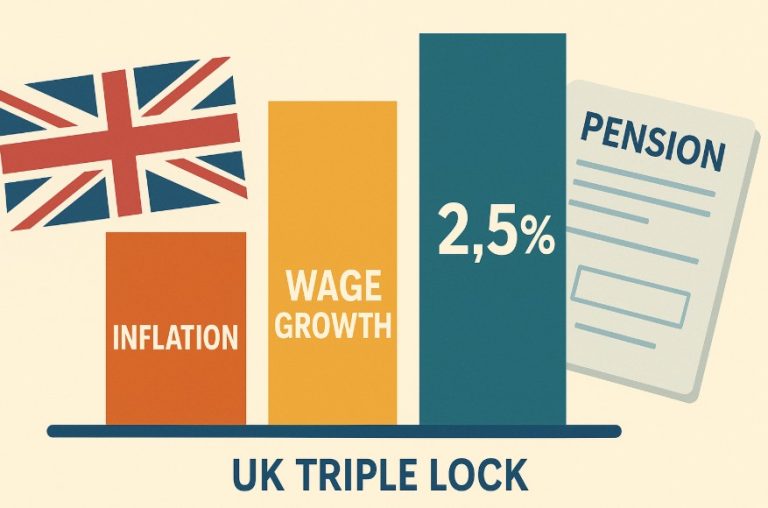New data from the Department for Work and Pensions has revealed a major shift in pension withdrawal behaviour across the UK.
As of 2025, updated savings withdrawal rules aim to address growing concerns over early access to retirement funds.
With millions of pensioners drawing down before the State Pension age, the government is introducing stricter regulations and revising access thresholds.
These changes are set to impact retirement planning, making it essential for seniors to reassess their long-term financial strategies.
What Is the New Savings Withdrawal Rule for UK Seniors in 2025?

In 2025, the UK government has taken further steps to refine the rules around pension withdrawals, particularly in response to increasing concerns that retirees are accessing their savings too early.
These new regulations aim to encourage more sustainable financial planning, protect long-term retirement income, and align with longer life expectancies.
The updates are not entirely new laws, but rather enhancements and forward-looking policies based on existing pension freedoms that were introduced in 2015.
The focus is now shifting toward managing access timing, encouraging longer pension preservation, and reducing the financial risk of running out of retirement funds.
Gradual Increase in the Minimum Pension Access Age
One of the most significant changes is the upcoming increase in the normal minimum pension age, which determines when individuals can start accessing their defined contribution pensions. This age is currently 55 but will rise to 57 from April 2028.
Although this specific rule does not come into effect immediately in 2025, it forms a crucial part of the evolving framework and is prompting pensioners and advisers to adjust financial plans now.
Key considerations include:
- Individuals born after April 1971 will be directly affected.
- Pension access plans made for mid-50s may no longer be valid.
- Retirement income strategies may require rebalancing to accommodate the two-year delay.
Alignment with Rising State Pension Age
The State Pension age in the UK currently stands at 66 for both men and women, but it is set to increase to 67 between 2026 and 2028, and to 68 between 2044 and 2046.
The decision to raise the minimum private pension access age to 57 is meant to align more closely with this trajectory.
This alignment is intended to:
- Encourage delayed retirement or phased retirement models.
- Reduce reliance on private pension savings in early retirement years.
- Promote greater personal responsibility for financial longevity.
For those considering early retirement, these changes may require a shift in planning, potentially increasing dependence on other savings or income streams before pensions become accessible.
Government’s Rationale for the Policy Shift
The rise in early pension withdrawals often taken as lump sums has raised red flags within both government and financial sectors. According to recent DWP data, more than £63 billion has been withdrawn by people under age 65 since the 2015 reforms. In response, the government is tightening access to pension savings to avoid:
- Overuse of pension pots before retirement truly begins
- Depletion of essential retirement income
- Financial hardship in later years
The overarching goal is to preserve pensions as vehicles for sustained income, rather than one-time cash access, which may not always be in the best interest of the retiree.
Impact on Retirement Planning for UK Seniors
The 2025 update to savings withdrawal rules is a clear indicator that the government expects retirees to manage their funds more conservatively and to plan for longer retirement periods.
Financial advisers are urging seniors and near-retirees to:
- Review their current retirement timelines
- Assess whether their savings will last under the new rules
- Consider diversifying income streams to cover the gap between early retirement and pension access
Those currently aged 50–54 must begin adjusting their financial plans now to reflect the two-year increase in access age. Delaying access may require increased savings or restructuring of investments to bridge the income gap.
Why Are More Seniors Withdrawing Pension Savings Before the State Pension Age?

Recent figures from the Department for Work and Pensions reveal that early pension withdrawals are now standard behaviour among UK retirees.
Since the pension freedom rules were introduced in 2015, a large proportion of savers have tapped into their pension pots well before reaching the State Pension age of 66.
More than two million individuals have withdrawn funds before qualifying for the State Pension.
In fact, around 72% of all flexible pension payments between 2015 and 2024 were made to those under 65, highlighting a shift in retirement habits.
Many of these withdrawals are taken as lump sums, suggesting that retirees may be prioritising short-term cash needs or lifestyle preferences.
However, this trend raises several concerns, particularly around long-term financial resilience, tax exposure, and market risks.
Among the possible drivers behind early pension withdrawals:
- Rising cost of living and inflationary pressure
- Delayed access to the State Pension, now set at age 66 and increasing
- Desire to phase into retirement rather than stopping work entirely
- Concern over future tax implications or changes in pension rules
Who Is Most Affected by the New Withdrawal Trends?
DWP data provides insight into how different age groups approach pension withdrawals. The highest number of withdrawals occurs in the 55–64 age bracket, with younger pensioners typically accessing smaller amounts on average.
However, the withdrawal amount tends to increase with age, likely due to larger accumulated pension pots and greater confidence in long-term income planning.
| Age Group | Number of Individuals | Total Amount Withdrawn | Average Payment |
| Up to age 59 | 1,291,000 | £35.59 billion | £27,600 |
| Age 60–64 | 827,000 | £28.56 billion | £34,500 |
| Age 65+ | 885,000 | £38.13 billion | £43,100 |
| All ages | 3,003,000 | £102.29 billion | £34,100 |
This pattern demonstrates the increasing use of pensions as flexible financial tools. Still, with nearly 35% of total withdrawals made by those under 60, the sustainability of such early access becomes questionable, especially if these funds are not being used for structured retirement income.
How Will the Increase in the Minimum Pension Age Impact Retirees?

The decision to increase the minimum pension access age from 55 to 57 by April 2028 is part of a broader strategy to align private pension access with longer working lives and increasing life expectancy.
As people are living and working longer, the government aims to ensure pension savings last through full retirement.
This move will have significant implications for individuals planning to retire in their mid-50s, especially those relying on defined contribution pensions for early income.
Some key implications of this change include:
- Individuals aged 50–54 today will be directly impacted by the new access age
- Early retirement strategies may need to be adjusted, particularly for those planning to withdraw funds before age 57
- Financial planners will need to account for the delayed access when advising clients on cash flow projections and retirement milestones
It’s also important to recognise that this is happening alongside the planned increase of the State Pension age, which will rise to 67 between 2026 and 2028, and eventually to 68 by the mid-2040s. The combined effect of these policies makes early pension planning even more critical for future retirees.
What Role Does Inheritance Tax Reform Play in Pension Withdrawals?
As part of broader financial reforms, the UK government has announced a significant change in how defined contribution pensions will be treated for Inheritance Tax (IHT) purposes.
Effective from April 2027, these pensions will be included in an individual’s taxable estate upon death, which is a major shift from existing rules.
This change has implications not just for estate planning but also for how seniors approach their pension withdrawals in the years leading up to retirement and beyond.
The Current Inheritance Tax Position on Pensions
Under the existing framework, most pensions are considered outside the scope of IHT, making them an effective tool for wealth preservation and transfer.
If a person dies before the age of 75, beneficiaries can usually inherit the remaining pension funds tax-free. If the person dies after 75, the beneficiaries pay income tax on the inherited amount but not IHT.
This has made pensions a preferred option for those looking to pass on assets to children or other heirs without incurring high tax charges.
As a result, some individuals have deliberately preserved pensions and drawn on other assets first during retirement to minimise their estate’s IHT exposure.
What Changes in April 2027?
From April 2027, defined contribution pension pots will be included in IHT calculations, meaning they will no longer enjoy full exemption from the estate’s total value.
This could push more estates above the IHT threshold (currently £325,000 for individuals, or up to £1 million with residence and transferable allowances), resulting in higher tax bills for heirs.
The key impacts of this change include:
- Reduced effectiveness of pensions as inheritance vehicles
- Greater urgency to utilise pension funds during the retiree’s lifetime
- Potential acceleration of pension withdrawals before death
This reform aims to improve tax fairness and prevent pensions from being used solely as tax shelters.
How Pensioners Are Reacting to the Upcoming IHT Reform?
In anticipation of these changes, more retirees are choosing to spend their pensions during their lifetime rather than leave them untouched. The logic is that it is better to enjoy the savings now or gift them (within annual gift allowances) than risk exposing them to a 40% IHT liability later.
This behavioural shift contributes to the increasing trend of early pension withdrawals, especially for those with larger pots who would be affected most by IHT inclusion. It’s also prompting people to reassess estate plans, including wills, trusts, and gifting strategies.
However, experts warn that withdrawing too much too soon can compromise financial stability in old age. It is crucial for pensioners to strike a balance between reducing potential IHT and maintaining income security.
Strategic Planning to Manage the Tax Implications
To navigate this changing landscape, financial planning will become even more essential. Strategies that can help mitigate the IHT impact on pensions may include:
- Phased withdrawals to reduce pension value gradually without entering a higher tax bracket
- Gifting withdrawn amounts within annual exemptions
- Utilising ISAs and other tax-efficient vehicles for transferring wealth
- Exploring trusts as part of broader estate planning
- Taking financial advice to optimise withdrawals and manage tax liabilities
While the upcoming rule aims to close tax avoidance loopholes, it also places a greater burden on retirees to proactively manage their pension usage with a long-term perspective.
Is the 4% Rule for Pension Withdrawals Still Relevant in 2025?

For decades, retirees have followed the 4% rule, which recommends withdrawing 4% of your pension pot annually to maintain long-term sustainability.
However, evolving economic conditions have led some experts to question the relevance of this guideline.
In today’s environment, where interest rates, inflation, and life expectancy are in flux, some financial planners suggest a 6% rule may be more appropriate at least in the early years of retirement when expenses are typically higher.
While increasing the withdrawal rate may allow retirees to enjoy a more comfortable early retirement, it carries the risk of outliving pension savings.
| Withdrawal Rate | Annual Income (Based on £250,000 Pot) | Risk of Fund Depletion |
| 4% | £10,000 | Low |
| 6% | £15,000 | Moderate to High |
| 8% | £20,000 | Very High |
This table highlights the trade-offs involved. While a higher withdrawal offers more income in the short term, it significantly increases the chance of running out of money in later life.
Therefore, individuals should consider using flexible drawdown strategies, regularly reviewing withdrawal amounts based on market conditions, spending habits, and life expectancy.
How Can Pensioners Plan for Sustainable Withdrawals?
As withdrawal flexibility increases, so does the responsibility to manage it wisely. Without employer-managed pensions or annuities to guide income distribution, individuals must make deliberate decisions about how to draw down their funds.
Effective planning includes:
- Setting clear financial goals for retirement
- Creating a budget that accounts for essential and discretionary spending
- Factoring in potential healthcare costs and inflation
- Planning for unexpected expenses such as family support or home repairs
It’s also highly advisable to make use of independent guidance services like Pension Wise, which offer free consultations for individuals aged 50 and over.
Professional financial advisers can also assist in creating withdrawal strategies that reflect individual circumstances.
A sustainable plan often includes diversified income sources, such as:
- Personal savings and investments
- Private pensions
- State Pension
- Rental or business income (if applicable)
Creating a balance between income reliability and flexibility will be key to managing retirement funds effectively under the 2025 withdrawal rules.
Conclusion
The 2025 pension withdrawal rule changes represent a significant shift in how retirement savings are accessed and managed in the UK.
With earlier withdrawals becoming increasingly common, pensioners must now consider the long-term implications of their financial decisions.
Understanding changes to minimum access age, tax liabilities, and estate planning is critical. Seeking professional guidance and staying informed about policy developments will help seniors secure sustainable income throughout retirement, avoiding financial shortfalls later in life.
FAQs About UK Seniors and the New Pension Withdrawal Rules
What is the new minimum pension access age in the UK?
The minimum age to access private pensions will rise from 55 to 57 in April 2028.
Can I take my pension before the State Pension age?
Yes, under current rules, you can access your private pension from age 55 (soon to be 57). However, doing so may reduce your long-term income.
How are pension withdrawals taxed in the UK?
Typically, 25% of your pension pot can be withdrawn tax-free. The remainder is subject to income tax based on your personal tax band.
Why are defined contribution pensions now included in inheritance tax?
From April 2027, defined contribution pensions will be included in the IHT estate to ensure fairness and close tax loopholes around unspent pensions.
What is the impact of early pension withdrawals on retirement income?
Withdrawing pension funds early can significantly reduce the amount available later in life, particularly if markets fluctuate or life expectancy increases.
Is financial advice mandatory before withdrawing pensions?
While not mandatory, seeking advice is highly recommended. Services like Pension Wise offer free guidance, and financial advisers can provide tailored strategies.
How much should I withdraw from my pension each year?
There’s no one-size-fits-all answer. While 4% is traditionally seen as safe, individual needs, market conditions, and life expectancy must all be considered.






